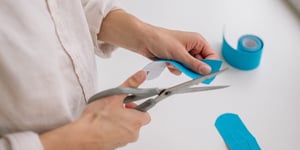What would you do if someone handed you a penny, and a pair of scissors, then told you to “get to work”?
Ten minutes and one scratched-up penny later, you’d have given up altogether.
You might have a fantastic design with a drawing to match, but it won’t mean anything if you can’t find a converter who can cut your chosen material into the shape you need.
Having specialized in rotary and laser die cutting for years, we’re confident in describing our different die cut capabilities; that’s why we at Strouse want to help you with your material solutions.
Once you’ve heard about the processability of different materials, you should know better whether your part is feasible and how to go about its production.
Which Flexible Materials Can You Die Cut?
If you were to ask, what can you cut? We’d reply, “Yes.”
Most flexible materials can be die cut, but when it comes to more challenging materials, you might struggle with the accuracy of the cuts.
Although Strouse could cut many of these materials they might not match your design specifications. Different factors determine how well a material cuts, so the question is, how accurate do you need its shape and tolerances?
These factors might seem new to you, but they’re crucial to the converting process, so look further if you’re wondering why we need to discuss your die cut tolerances.
Let’s read through some of the typical characteristics of materials we regularly process:
DOES IT CUT WITH SCISSORS?
One simple test to gauge the feasibility of converting a particular material is by taking a pair of scissors and cutting it.
Then ask yourself:
- Does it cut smoothly?
- Does it hold its shape?
- Does it slice in a straight line?
If the answer to these questions is “no,” you might want to prepare for a more difficult converting process involving longer setup times, more adhesive waste, and higher-costing die cuts.
Finally, how does your material behave after it’s been cut: Does it ooze like hydrogels or hydrocolloids? Some materials act like peanut butter when you cut them, so make sure not to end up with a complex process and then regret it.
TAPE OFF THE SHELF
Whether or not you’ve visited the home improvement store recently, the tape off the shelf can be an excellent example of adhesives we’re fit to process.
When it comes down to types of material you could grab off the shelf at a home improvement store, there’s a high chance we can process it.
If you’re stuck between a few materials or unsure which to use, you can always try out the Sample Express:
Sample Express allows you to alter your design to decide if it looks or works better with a different material or adhesive substrate. Instead of marrying one design forever, try and see if you can find solutions to current dilemmas by changing up the adhesive formula.
MATERIALS FROM A ROLL
If your flexible material comes on a roll, it’s a good indicator that we’ll be able to run it on a press.
Examples of flexible materials on a roll include fabric, film, rubber, or various adhesive options.
Unfortunately, not all rolled materials are easy to run. Take butyl tapes, for instance, which are used for gasketing but are challenging to slice because they’re thick and sticky like road tar.
While it’s possible to cut these materials, you should note some important drawbacks:
4 Most Challenging Materials to Die Cut
Working with a challenging material can be unavoidable, but you might want to prepare yourself for delays or higher processing costs.
Once you’ve read through these qualifications, you’ll better understand why certain materials are more difficult to process and what it means for you.
UNSUPPORTED MATERIALS
First of all, if your material comes with a liner attached, it’ll likely have the stability for die cutting.
If the material you choose doesn’t have a liner and is stretchy, nothing will prevent it from flopping around on the rotary die cut press. Even if a material stretches, the moment we apply adhesive, it won’t snap back to its original shape properly anymore.
If you want to use a less challenging material and pay less for setup costs, find a material with a liner.
ELASTIC MATERIALS
The greatest strength of elastic materials is the same as their biggest weakness: they stretch.
Elastic materials are difficult to configure on a press because it takes lots of trial and error to determine the correct amount of tension a converter should be using.
Setting up a rotary die press requires the material to retain a certain level of tension on the machine press. If you have insufficient tension, your material will hang like limp noodles, whereas too much can lead to significant sizing issues.
When the length of the material is stretched and cut, the parts will snap back and be at a different size afterward. Your converter must consider elasticity to prevent the wrong part tolerances.
ABRASIVE MATERIALS
Abrasive materials include adhesives with hard components, such as glass, titanium oxide, or soft metals: think sandpaper or safety-walk.
The effect abrasive materials have on a die tool is similar to using scissors to cut sandpaper. The longer you cut the sandpaper, the duller the blades become until eventually, they’re clamping down on it without any effect.
Materials like sandpaper or white ink wear on the blade quickly, and while it is possible to cut these abrasive materials, they often lead to retooling costs further down the road.
If you’ve got a project that uses abrasive materials, you might want to discuss retooling with your converter.
THICK MATERIALS
Cutting thick material is more difficult because as the blade sinks deeper, the edges bend, altering the shape of the cut. It’ll give the material an hourglass effect.
In addition, thicker materials are difficult to laser cut because the laser begins to skew as it slices through the material, so for thicker materials, laser die cutting isn’t a good long-term solution.
Because Strouse has processed many thick materials in the past, we know that there’s a higher potential for setup waste and that the machine may have to run slower, resulting in a more expensive final product.
Whether or not you can change your material later on will also depend entirely on how much tooling you’re willing to pay for and the nature of your design.
If your design has tight tolerances, but you decide to switch the material to thick foam, not only will the production setup time and waste increase, but it will also be costly to reach your previous tolerances.
What Else Do I Need to Know About Flexible Materials?
Using more challenging flexible materials isn’t the end of the world. That being said, it might save you time and money to consider how complex a material is before you choose a particular one.
Ask your converter if the material you want to use applies to the part you want to build. When there’s no way around challenging materials, one last way to make the process easier is by optimizing your design as much as possible.
Lastly, if you want to learn more about our die cutting capabilities, see our manufacturing capability one-pager:







